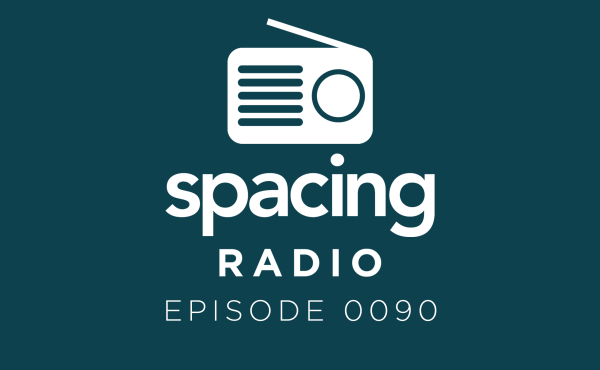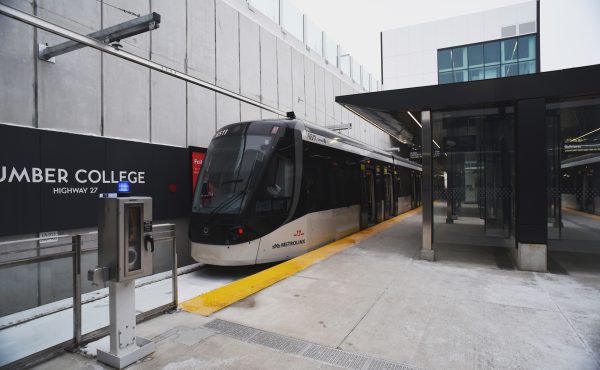In the wake of last week’s decision to continue to build-out Toronto’s LRT plans — and since Mayor Rob Ford continues to mistakenly call any LRT project a streetcar line — Spacing will profile a handful of LRT projects from around the world that will give readers a little better understanding of this transit option.
![]()
Last year Melbourne, Australia was ranked world’s most liveable city by the Economist. Not surprisingly, a qualifying feature of this title is the presence of an efficient transit system.
Melbourne’s longstanding tramway network – the largest urban LRT system in the world – consists of 250 km of track, 487 trams, 30 routes, and 1,763 tram stops. In 2010-2011, 182.7 million passenger trips were made by tram, representing a 4.1% year-on-year patronage growth.
But Melbournian trams serve more than the utilitarian purpose of transporting people from A to B. Riding trams are an essential part of the city experience. Toronto take note!
Melbourne’s tram network operates in both mixed-traffic and separate ROW situations, not unlike our own. In fact about 82% of the network is either in full mixed traffic or in reserved lanes marked by a yellow line, with no physical barrier. Often, cars are permitted on the tram lane during off peak hours, easing congestion.
The tramway employs a zone fare system, with Zone 1 covering the downtown and the inner suburbs, and Zone 2 the outer suburbs. Zone boundaries overlap, and as such two-zone fare payments are rare, occurring solely when traveling completely through the other zone. A discounted “City Saver” fare is available for travel in the inner city, at $2.40 a ride.
The network is operated under contract, the current private operator is Yarra Trams. Ticketing, public information, and patronage promotion are undertaken by Melbourne’s multi-modal service provider, Metlink.
Trams are a distinctive feature of tourism in Melbourne. The city offers a free route that runs through the downtown core during daylight hours. The City Circle Tram service operates within the central business district, passing major tourist attractions, as well as linking with other tram, train and bus routes in and around Melbourne. The vintage trams constitute some of the oldest in the city, and a recorded voice narrates the history of the buildings and locations as you pass them.
Melbourne operates the world’s first restaurant tram. Again, refurbished older trams equipped with special hydraulics, tinted windows, chandeliers, and fancy curtains serve as roaming dining halls, offering full-course luncheons and dinners.
Most of Melbourne’s fleet are high-floor vehicles with steps to climb up from street level. The city has retained and re-purposed older W-class trams, and introduced new low-floor vehicles, including 36 Alstom Citadis and 59 Siemens Combino models.
Toronto is not far behind. Each year over 52 million riders board 248 streetcars and traverse 75 kilometres of track on 11 routes. We are iconic among transit fans in North America for having the continent’s most extensive streetcar system. As Spacing noted back in 2006, “with a few tweaks and a splash of creativity, our streetcar network could become, in its own way, a proud celebration of that fact.”
Photo via Australian Stock Images




17 comments
Link to the Tram map http://www.metlinkmelbourne.com.au/assets/PDFs/maps/Train-and-tram-network/TramNetworkMap.pdf (big 2.1MB and slow to load) but interesting.
Love the restaurant tram idea. TTC take note!
I’ve been waiting ten years for this post. Thank you, great article. Should be required reading for Fordian dolts who don’t understand what a large modern streetcar system looks like (with some mild LRT upgrades).
The TTC and/or Metrolinx and/or a coalition of LRT supporters should invest in a series of advertisements showing CGI demos of what the Eglinton LRT will look like in situ. Screen them as often as possible on the TTC info screens, as flash ads on local websites, and on CP24 and local stations.
You folks are so desperate to say I told you so. It would help if you made a point of comparing apples with apples. From the pictures that were used it looks like the track is at grade. Where is the raised dedicated rail bed, all 6-8 inches of it, that will create additional congestion that is part of the design for Toronto implementation. I don’t see any cars. The first picture looks like a deserted city. That’s absolutely amazing. Implement surface rail like they have in Melbourne and all your cars disappear. The other consideration, or at least I think it should enter into the discussion, there is no snow in Melbourne.Toronto can’t make that claim. So in Melbourne unlike Toronto people don’t have to stand in the cold right. Because there is no snow you don’t have to clear the tracks at rush hour and make everyone late for work.There is no salt on the streets therefore damage due to corrosion isn’t an issue. Right?
We had streetcars in the downtown but removed most of them a long time ago and installed subways and don’t tell me the density was there to justify them because frankly I don’t think it was ever brought up. Our City fathers wanted to get rid of the congestion that streetcars created in the downtown so they funded subways out of the fare box by the way not by taxing property owners.
Regards,
Just another Fordian dolt
Patrick,
– There are lots of other cold weather cities that use trams, LRTs, and streetcars, including Western Europe and Finland, where is snows.
– There is lots of space for cars in the picture, and in the LRT plan. Where will the cars go? In the lanes that aren’t taken up by the streetcar tracks.
– We still have lots of streetcars downtown. They work fine, even in snow. – In wintertime, people dress for winter. Even if your subway stop is underground, you have to some to the surface to get anywhere. Cold weather is a moot point. – The picture looks like a deserted city because it’s in the burbs. You know, like Eglinton East-style burbs.
Your signoff says it all, Patrick.
Patrick, I especially like the part where you say that we removed most of the streetcars downtown. Classic!
problem is melbourne is half the population of toronto … and we’re on the “grow” to a regional pop of nearly 10 million in 20 years …
Al, Melbourne’s population is 4.6MM. The GTA’s is 5.1.
They’re the same size. You can google it.
PG, the GTA CMA is 6,574,140 as of 2011 and projected to grow to 8.6 million by 2031. Melbourne’s CMA is static/slow growth at 3,132,806.
Neptis foundation and Stat Can sources. Key here is that our region is growing fast and we need to build for it. I couldn’t care less about the technology debate of heavy rail vs. light rail. build the modes where they WILL make sense.
Small correction to comment above by AI: the GTA is *not* 6.5-million. That’s the GTHA, which includes Hamilton and St Catharine’s, Niagara Falls.
Metro Melbourne is actually quite a perfect comparable to the GTA.
Patrick: Edmonton and Calgary have LRT lines and have little problems with the tracks during the winter and all operate in their own Right Of Way. And the only streetcar lines that have been removed in the last 50 years were Yonge and Bloor/Danforth lines. That is not “most” of the lines, only 2. Certainly Toronto had lots of tram lines pre-WWII but most of those lines were replaced by buses, not subways.
iSkyscraper, the serious design and operational problems with Toronto’s streetcar system are decades old, and have spanned multiple administrations of all political stripes. It doesn’t take a “Fordian dolt” to realize that.
The “people will get cold” argument for subways seems a pretty weak argument to begin with, but it falls apart even further with a bit of bigger-picture thinking. If you take as given:
1) People walk to/from subway/LRT stations
2) Subway stations cost 20x as much as a surface LRT station
3) A subway train carries 2x as many people as a multi-car LRT
then the end result of spending 10x more on a subway is having fewer station stops spaced further apart, subway trains running less frequently (for a given passenger demand), and therefore passengers would have to walk further to a subway station, and wait there longer.
It seems most of these Subway arguments are more arguments about neighborhood status, who ‘deserves’ what, and making sure that the only thing blocking cars is hundreds more cars.
Just a small expansion on Mick’s comment: the Yonge and Bloor streetcars weren’t the only streetcar routes to be removed after the war; the Harbord streetcar, which connected Davenport to what’s now Pape Station in a meandering manner was shut down in the 1960s after the Bloor subway opened, the same happened to the Dupont/Bay streetcar after the University branch opened, and the line along Rogers Road went down in the ’70s. The modern Toronto streetcar system is a fragment of what it was sixty years ago.
I think it should be pointed out that the TTC no longer fields 248 streetcars. One was recently destroyed, and the fleet was allowed to rot after the deep cuts in the mid 90’s. At rush hour only 189 streetcars plie the 94 km of streetcar trackage.
Which brings us to the issue of the replacement cars recently reduced in number from 204 in the original order to 189. The claim is that they are bigger and thus offer more capacity, but headways on many routes (particularly off peak) are a shadow of the service the TTC used to run. I believe that Steve Munro made the point that the TTC requires 322 streetcars to account for system expansion and ridership growth while accomodating headways last seen in the late 80’s early 90’s.
Patrick’s notion that the Subway system was funded ‘from the fare box’ is pretty interesting. The TTC did actually once work without a large operating subsidy, that all changed when it morphed into a system serving commuters coming in the low-density suburbs. Relatively underused subway lines like Spadina and Bloor/Danforth already do not recoup their operating cost through fares and are a big reason that the TTC is now reliant on an operating subsidy. Building high capacity heavy-rail subways through low-density inner suburbs will financially cripple the TTC in the long term. The operating budget will skyrocket without the necessary ridership increase to compensate, this will force a huge increase in its operating subsidy which is funded largely from property tax. Building subway instead of LRT now will very likely result in higher property taxes later. This is why the fact that it is being pushed by supposed fiscal conservatives is so preposterous.